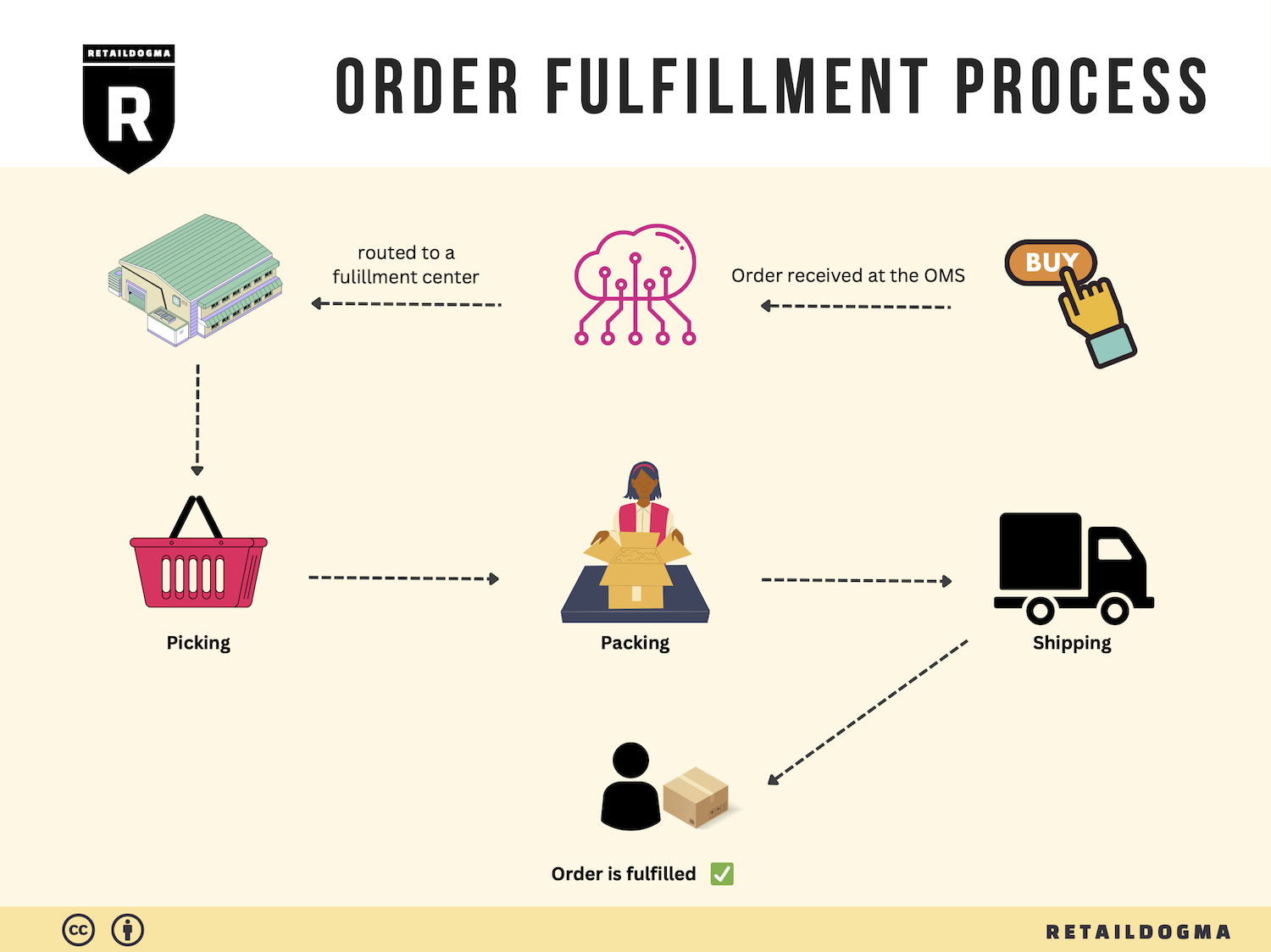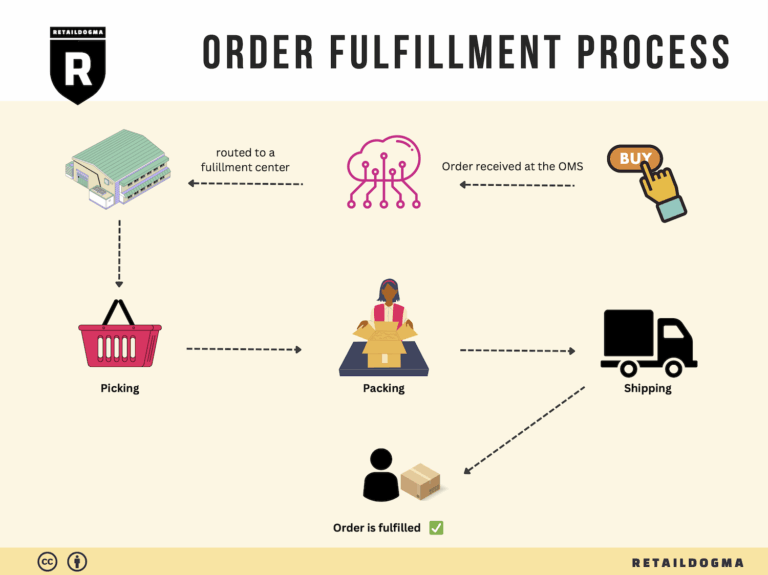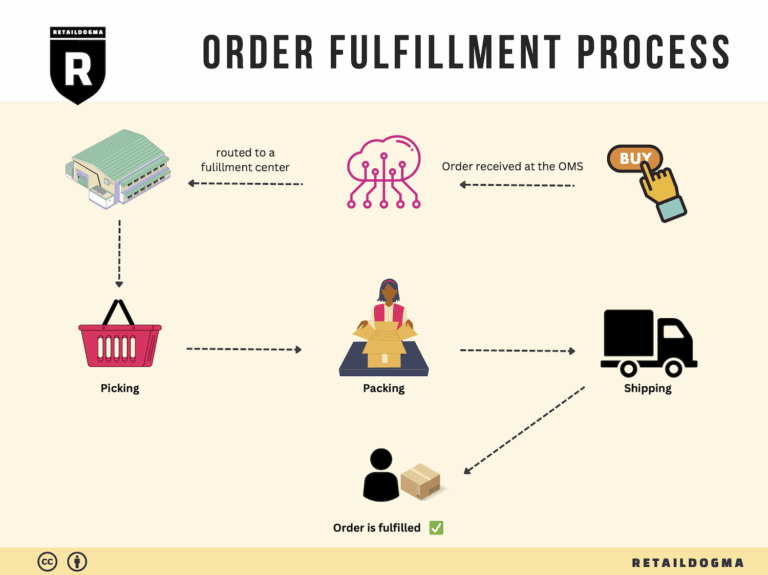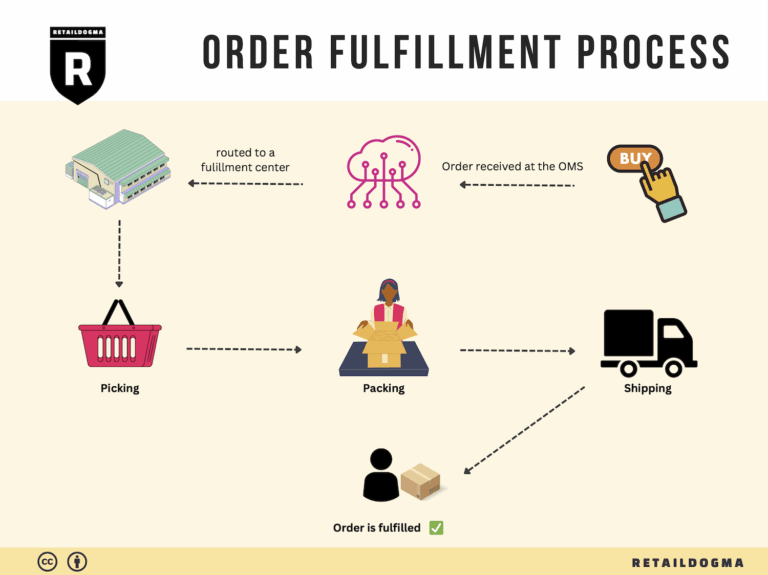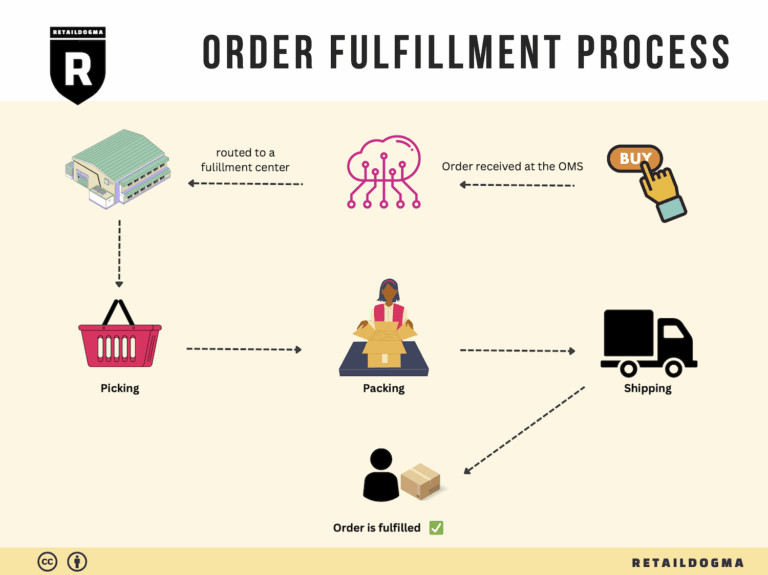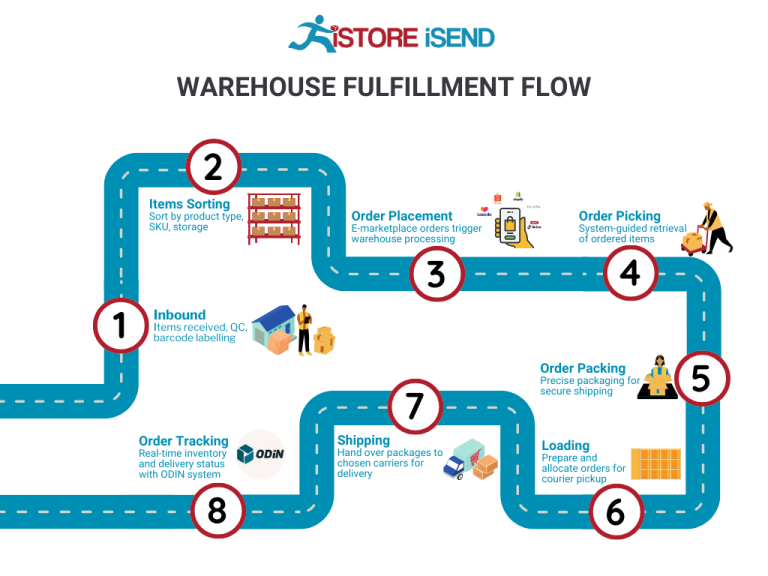What Is A Fulfillment Center? A Complete Guide (2025)
What is E-commerce Fulfillment? An Introduction for Growing Businesses
Understanding the Challenges of E-commerce Fulfillment
As a growing online business, you may find yourself grappling with the complexities of packing and shipping orders. The excitement of increasing sales can quickly turn into overwhelm as you juggle inventory management, order processing, and the logistics of getting products to customers. This is a common pain point for many e-commerce entrepreneurs. The challenge lies not only in fulfilling orders but in doing so efficiently and accurately, all while keeping costs manageable.
At its core, e-commerce fulfillment is the process of getting a product from your warehouse or fulfillment center to your customer’s doorstep. It encompasses a range of tasks, including receiving inventory, processing orders, picking items, packing boxes, and shipping. For businesses that are scaling, these tasks can become time-consuming and fraught with challenges, leading to potential delays and customer dissatisfaction.
In this guide, we will explore the various e-commerce fulfillment models available to you, such as third-party logistics (3PL) and Fulfillment by Amazon (FBA). Understanding these models will help you choose the right approach based on your business needs and growth trajectory.
We will delve into the core services that comprise the fulfillment process, including inventory management, order processing, warehousing, shipping, and returns management. Each of these elements plays a crucial role in ensuring that your fulfillment operations run smoothly and efficiently.
Choosing the right fulfillment partner is vital for your business’s success. This guide will provide insights into what to look for in a fulfillment provider, including their technology capabilities, service offerings, and pricing structures. We will also discuss how to assess the costs associated with fulfillment so you can make informed financial decisions.
Ultimately, the goal of this guide is to empower you, the business owner, to make smart decisions about your logistics. By understanding the intricacies of e-commerce fulfillment and leveraging the right strategies and partners, you can enhance your operational efficiency, improve customer satisfaction, and drive sustainable growth for your online business.
What You’ll Learn In This Guide
- What is E-commerce Fulfillment? An Introduction for Growing Businesses
- The Order Fulfillment Process: From ‘Buy’ Button to Customer’s Door
- Comparing Fulfillment Models: In-House vs. 3PL vs. Dropshipping
- A Deep Dive into Amazon FBA: Pros, Cons, and Who It’s For
- Core Services Offered by Fulfillment Centers
- How to Choose a Fulfillment Partner: A 6-Point Checklist
- Understanding Fulfillment Pricing: A Breakdown of Common Fees
- Frequently Asked Questions (FAQs) about Fulfillment
- Conclusion: Is Outsourcing Fulfillment the Right Move for Your Business?
- Important Disclaimer
The Order Fulfillment Process: From ‘Buy’ Button to Customer’s Door
1. Receiving Inventory
The order fulfillment process begins with receiving inventory from suppliers or manufacturers. This step involves checking the incoming shipments against purchase orders to ensure accuracy and completeness. Key tasks include inspecting items for damage, verifying quantities, and recording them into the inventory management system (IMS) using Stock Keeping Units (SKUs) for easy tracking.
Importance: Proper receiving is crucial because it sets the foundation for effective inventory management. If discrepancies occur at this stage, they can lead to stockouts or overstock situations, which can disrupt order fulfillment and negatively impact customer satisfaction. By accurately logging inventory, businesses can maintain optimal stock levels, ensuring that they meet customer demand without incurring unnecessary holding costs.
2. Warehouse Storage
Once inventory is received and verified, it is stored in a warehouse. Efficient warehousing involves organizing products in a way that maximizes space and facilitates easy access. This is often done using a Warehouse Management System (WMS), which helps track the location of each item, manage stock levels, and streamline retrieval processes.
Importance: Effective warehouse storage is vital for operational efficiency. Well-organized inventory not only speeds up the picking process but also minimizes the risk of errors and damage. A WMS allows businesses to implement systems such as FIFO (First In, First Out) or LIFO (Last In, First Out), depending on the nature of the products. This organization ensures that products are shipped in a timely manner, reducing the likelihood of obsolescence.
3. Order Picking
When a customer places an order, the next step is order picking, where warehouse staff gather the items needed to fulfill that order. This process is often guided by pick lists generated by the IMS, which detail the specific products and their locations within the warehouse.
Importance: Order picking is a critical step because it directly impacts the speed and accuracy of order fulfillment. Inefficient picking processes can lead to delays and errors, resulting in customer dissatisfaction. Utilizing technologies such as barcode scanning and mobile picking solutions can enhance picking efficiency and accuracy, reducing the chances of shipping incorrect items.
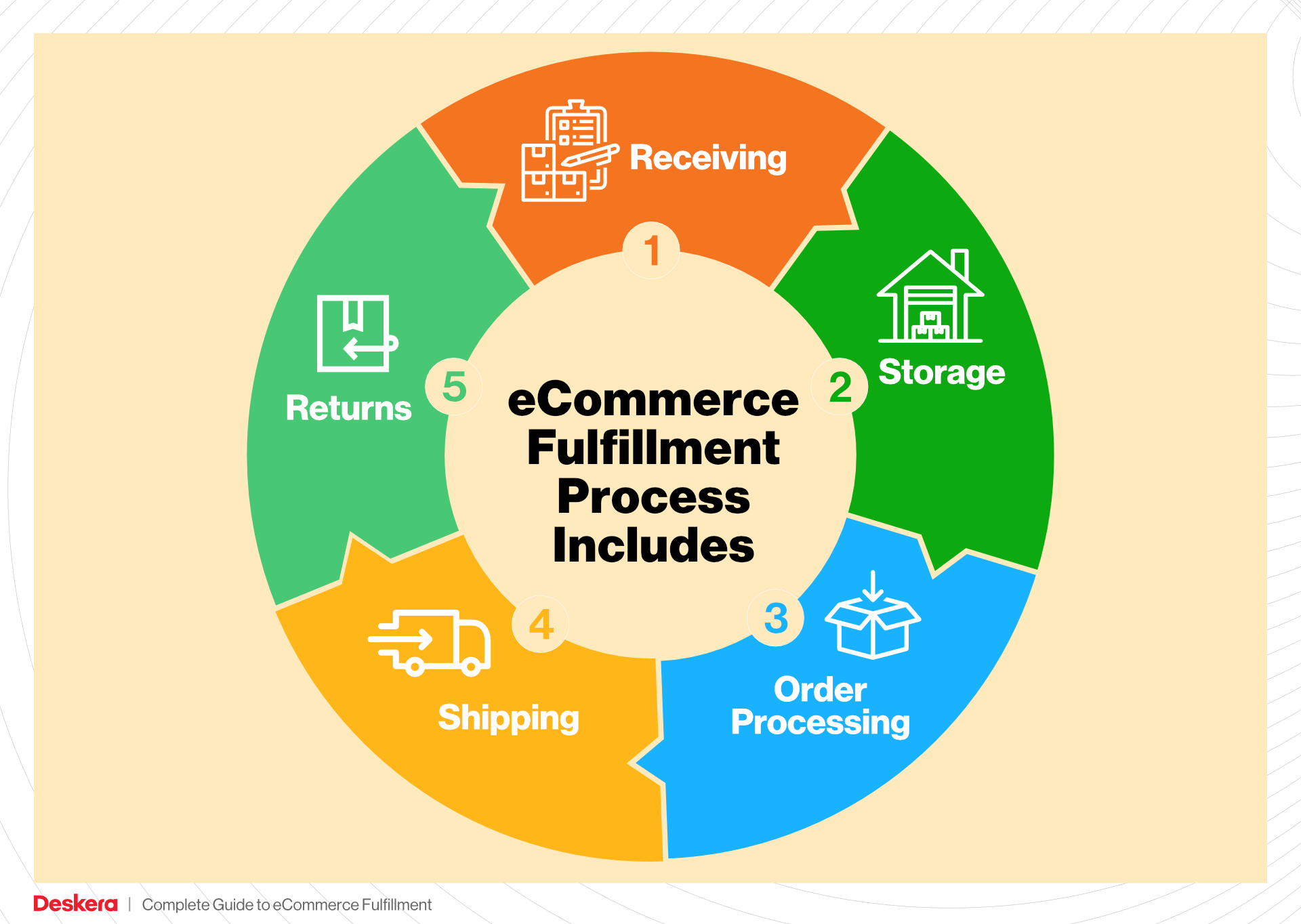
4. Order Packing
After items are picked, they are prepared for shipping in the packing stage. This involves securely packaging the products to prevent damage during transit and including necessary documentation, such as packing slips and return labels. Businesses often use packing stations equipped with tools like tape dispensers, scales, and printers to streamline this process.
Importance: Proper packing is essential for protecting the products and ensuring a positive unboxing experience for customers. Well-packed orders reduce the likelihood of returns due to damage, thereby lowering costs associated with reverse logistics. Additionally, including information on returns can enhance customer satisfaction and loyalty, as it makes the return process seamless.
5. Shipping & Delivery
The final step in the order fulfillment process is shipping and delivery. Once the order is packed, it is handed over to a shipping carrier, which transports it to the customer’s specified address. Businesses must choose shipping options based on factors such as cost, speed, and geographic coverage, often leveraging relationships with carriers to secure favorable rates.
Importance: The shipping and delivery stage is the culmination of the entire fulfillment process and significantly impacts customer satisfaction. Fast and reliable delivery can lead to repeat business and positive reviews, while delays or issues can damage a brand’s reputation. Offering multiple shipping options (e.g., standard, expedited, or same-day delivery) can cater to different customer needs, enhancing the overall shopping experience.
In conclusion, understanding and optimizing each step of the order fulfillment process is essential for e-commerce businesses looking to scale. By effectively managing receiving, storage, picking, packing, and shipping, companies can ensure timely deliveries, minimize costs, and ultimately drive customer satisfaction.
Comparing Fulfillment Models: In-House vs. 3PL vs. Dropshipping
Fulfillment Model Comparison Table
| Model | Who Handles Inventory | Best For (Business Stage) | Key Advantage | Key Disadvantage |
|---|---|---|---|---|
| In-House Fulfillment | The business itself | Startups to established brands | Complete control over inventory and fulfillment process | High upfront costs and resource-intensive |
| Third-Party Logistics (3PL) | The 3PL provider | Growing businesses scaling operations | Cost-effective scalability and expert logistics management | Less control over the fulfillment process |
| Dropshipping | The supplier/manufacturer | New entrepreneurs or niche markets | Low initial investment and minimal overhead | Lower profit margins and reliance on supplier reliability |
In-House Fulfillment
In-house fulfillment refers to the practice of managing the entire order fulfillment process within the business itself. This model is often adopted by startups and established brands that want complete control over their inventory management, order processing, and shipping. By handling fulfillment in-house, businesses can tailor their logistics to meet specific customer needs and ensure that they maintain quality control throughout the process. However, this approach comes with significant challenges. Managing inventory, packing, and shipping can be resource-intensive, requiring significant investments in warehousing space, technology, and personnel. As a company grows, the complexities of in-house fulfillment can lead to inefficiencies and increased operational costs. Thus, while this model allows for high levels of customization and direct oversight, it may not be sustainable for businesses looking to scale rapidly.
Third-Party Logistics (3PL)
Third-party logistics (3PL) involves outsourcing the fulfillment process to a specialized service provider. This model is ideal for growing businesses that are scaling their operations but may not have the infrastructure or expertise to handle fulfillment effectively. By partnering with a 3PL, businesses can leverage the provider’s established logistics network, technology, and expertise in inventory management. This not only reduces overhead costs but also allows businesses to focus on core activities such as marketing and product development. The key advantage of 3PL is the ability to scale quickly without the need for heavy investment in warehouse space or logistics technology. However, outsourcing fulfillment does mean that businesses have less control over the process, which can lead to challenges in maintaining consistent service quality and handling returns effectively. It’s essential for businesses to choose the right 3PL partner to align with their fulfillment goals and customer service standards.
Dropshipping
Dropshipping is a fulfillment model where the retailer does not keep products in stock. Instead, when a customer places an order, the retailer purchases the item from a third-party supplier, who then ships it directly to the customer. This model is particularly appealing for new entrepreneurs or those operating in niche markets, as it requires minimal upfront investment and overhead. Retailers can offer a wide variety of products without the need to manage inventory or handle shipping logistics. However, dropshipping comes with its own set of disadvantages. Profit margins can be significantly lower compared to other fulfillment models due to the reliance on suppliers, who may charge higher prices for their services. Additionally, retailers are dependent on suppliers for inventory quality and shipping timelines, which can lead to customer dissatisfaction if issues arise. Overall, while dropshipping offers a low-risk entry point into e-commerce, it requires careful management of supplier relationships and customer expectations to ensure long-term success.
Conclusion
When choosing a fulfillment model, e-commerce business owners must consider their current business stage, growth ambitions, and operational capabilities. In-house fulfillment offers control and customization but can be resource-intensive. Third-party logistics (3PL) provide scalability and expertise, making them a suitable choice for growing businesses. Lastly, dropshipping allows for low-risk entry into the market, though it may come with challenges related to profit margins and supplier reliability. By carefully evaluating each model’s advantages and disadvantages, businesses can make informed decisions that align with their strategic goals and customer expectations.
A Deep Dive into Amazon FBA: Pros, Cons, and Who It’s For
Understanding Fulfillment by Amazon (FBA)
Fulfillment by Amazon (FBA) is a service offered by Amazon that allows sellers to store their products in Amazon’s fulfillment centers. Amazon then takes care of storage, packaging, shipping, and customer service for these products. This service enables e-commerce businesses to leverage Amazon’s extensive logistics network and customer trust, facilitating faster delivery and improved customer satisfaction.
How FBA Works
-
Account Setup: Sellers must first create an Amazon seller account and choose to enroll in FBA.
-
Product Listing: Once enrolled, sellers can list their products for sale on Amazon. When setting up their listings, they indicate which products they want to fulfill through FBA.
-
Shipping Inventory to Amazon: Sellers prepare and ship their products to Amazon’s fulfillment centers. Amazon provides guidelines on how to package and label items to ensure they are processed efficiently.
-
Storage and Order Management: Once the products arrive at the fulfillment center, Amazon stores them until a customer places an order. FBA manages the entire order process, from picking and packing to shipping.
-
Customer Service and Returns: Amazon handles customer inquiries and returns, which simplifies the process for sellers. This includes processing returns and refunds in accordance with Amazon’s policies.
-
Payment: After a sale is made, Amazon deducts its fees and transfers the remaining funds to the seller’s account, typically on a bi-weekly basis.
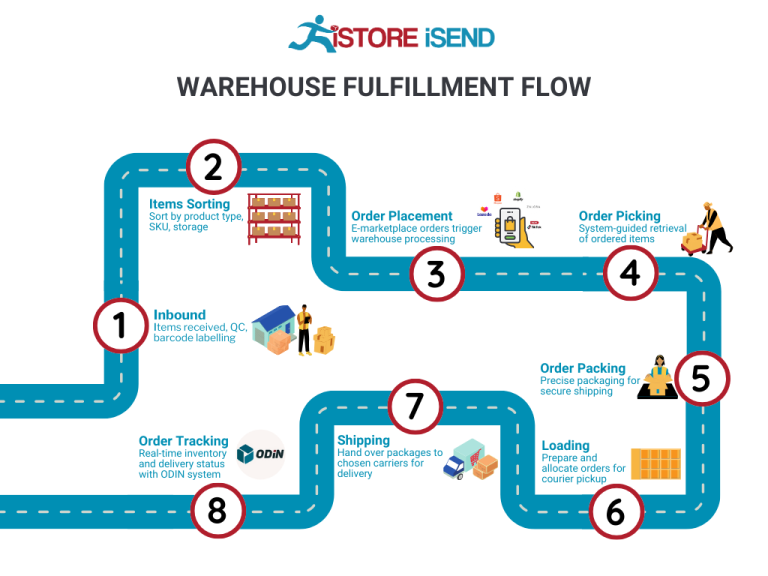
Pros of Using Amazon FBA
-
Prime Eligibility: Products fulfilled through FBA are eligible for Amazon Prime, which can significantly increase sales. Prime members tend to prefer products that offer fast, free shipping, making FBA an attractive option for sellers.
-
Customer Trust: Leveraging Amazon’s established reputation can enhance customer trust. Many consumers feel more confident purchasing items that are fulfilled by Amazon due to the company’s commitment to customer service and reliable shipping.
-
Multi-Channel Fulfillment: FBA allows sellers to utilize Amazon’s logistics capabilities not just for sales on Amazon, but also for other sales channels. Sellers can fulfill orders from their own websites or other marketplaces using the same inventory stored in Amazon’s warehouses.
-
Scalability: FBA provides a scalable solution for growing businesses. As demand increases, sellers can send more inventory to Amazon without worrying about the logistics of storage and fulfillment.
-
Reduced Operational Burden: By outsourcing logistics to Amazon, sellers can focus on other critical areas of their business, such as product development and marketing.

Cons of Using Amazon FBA
-
High Fees: FBA comes with various fees, including storage fees for keeping inventory in Amazon’s warehouses and fulfillment fees for processing orders. These costs can accumulate, especially for sellers with slow-moving inventory, potentially eroding profit margins.
-
Strict Inventory Rules: Amazon has stringent rules regarding inventory management, including how products should be packaged and labeled. Non-compliance can lead to additional charges or even the removal of inventory from Amazon’s warehouses.
-
Commingling Risks: FBA allows sellers to commingle their inventory with that of other sellers. This means that when a seller sends in their products, they may be mixed with similar items from other sellers. If there are issues with quality or returns, it can be difficult to trace problems back to the original source, potentially impacting brand reputation.
-
Loss of Control: By using FBA, sellers hand over significant control over their fulfillment process to Amazon. This can lead to challenges in managing customer relationships, as sellers may not have direct access to customer feedback and inquiries.
-
Complex Returns Management: While Amazon handles returns, the process can sometimes be complicated for sellers, especially if they need to manage inventory levels or restock returned items.
Who is FBA Best For?
Fulfillment by Amazon is particularly beneficial for small to medium-sized e-commerce businesses looking to scale without the overhead of managing logistics. Here are some specific scenarios where FBA shines:
-
New Sellers: Entrepreneurs starting their e-commerce journey can benefit from Amazon’s established infrastructure and customer base, reducing the barriers to entry.
-
Brands with Established Products: Sellers with proven products that have consistent demand can leverage FBA to handle logistics efficiently, allowing them to focus on scaling their brand.
-
Seasonal Businesses: Companies that experience seasonal spikes in demand can use FBA to manage inventory without committing to long-term warehousing.
-
Multi-Channel Sellers: Businesses selling on various platforms (like Shopify or eBay) can use FBA to streamline their fulfillment process across all channels while still maintaining a presence on Amazon.
-
Brands Seeking Global Reach: FBA provides sellers with the opportunity to reach international markets through Amazon’s global network, making it easier to expand without setting up logistics in each region.
In conclusion, while FBA offers numerous advantages, such as increased sales potential through Prime eligibility and reduced operational burdens, sellers must also weigh the associated costs and potential risks. By understanding the nuances of FBA, e-commerce businesses can make informed decisions that align with their growth strategies and operational capabilities.
Core Services Offered by Fulfillment Centers
Inventory Management & Warehousing
Inventory management and warehousing form the backbone of any successful e-commerce fulfillment operation. This service encompasses the systematic tracking and storage of products until they are sold. A fulfillment center provides a secure environment where businesses can store their inventory, often utilizing advanced Warehouse Management Systems (WMS) to streamline operations.
Benefits:
1. Optimized Stock Levels: Fulfillment centers help businesses maintain optimal inventory levels, reducing the risk of stockouts or overstock situations. This balance is critical for cash flow management and ensures that businesses can meet customer demand without incurring excess storage costs.
-
Real-Time Tracking: With sophisticated inventory management tools, businesses gain visibility into their stock levels, sales trends, and inventory turnover rates. This data allows for informed decision-making regarding reordering and product launches.
-
Scalability: As an e-commerce business grows, the need for more storage and efficient inventory management becomes paramount. Fulfillment centers can easily scale operations to accommodate increased stock and order volumes, enabling businesses to grow without the hassle of managing logistics in-house.
Pick and Pack Services
Pick and pack services are essential to the fulfillment process, involving the picking of ordered items from the warehouse and packing them for shipment. This process is crucial for ensuring that orders are accurately fulfilled and delivered to customers in pristine condition.
Benefits:
1. Accuracy and Efficiency: Fulfillment centers employ trained staff and automated systems to ensure that items are picked accurately. This reduces the likelihood of shipping errors, which can lead to customer dissatisfaction and increased return rates.
-
Time-Saving: By outsourcing pick and pack services, e-commerce businesses can save significant time and resources. This allows them to focus on core activities such as marketing and product development, rather than getting bogged down in logistics.
-
Cost-Effective Operations: Fulfillment centers benefit from economies of scale, which often translates to lower operational costs. By leveraging these services, businesses can reduce their overall fulfillment costs while enhancing service quality.
Kitting and Assembly
Kitting and assembly services involve the grouping of individual items into ready-to-ship sets or kits. This process can include assembling products that require multiple components or bundling related products for promotional offers.
Benefits:
1. Enhanced Customer Experience: Offering pre-assembled kits can simplify the purchasing process for customers. This convenience often leads to increased sales, as customers appreciate the ease of finding bundled products.
-
Increased Sales Opportunities: Kitting allows businesses to create special offers or bundles that can drive additional sales. For example, selling a skincare regimen as a complete kit rather than individual products can enhance perceived value and encourage bulk purchases.
-
Efficient Use of Resources: By outsourcing kitting and assembly to a fulfillment center, businesses can take advantage of specialized labor and equipment, thereby freeing up their own resources for other critical tasks.
Returns Management (Reverse Logistics)
Returns management, or reverse logistics, is the process of handling returned items efficiently. This includes receiving returns, assessing their condition, restocking them if possible, and managing customer refunds or exchanges. A well-structured returns process is vital for maintaining customer trust and satisfaction.
Benefits:
1. Streamlined Process: Fulfillment centers often have established protocols for handling returns, which can significantly reduce the time and effort required for processing. This efficiency minimizes disruption to inventory and allows businesses to quickly reintegrate returned products back into stock.
-
Customer Retention: A smooth returns process enhances customer experience and encourages repeat business. When customers know that returns will be handled efficiently, they are more likely to make a purchase, knowing they can return items if necessary.
-
Data Insights: Analyzing return trends can provide valuable insights into product performance and customer preferences. Understanding why items are returned can help businesses make informed decisions about product quality, marketing strategies, and inventory management.
Conclusion
The core services offered by fulfillment centers are integral to the success of e-commerce businesses. By leveraging inventory management, pick and pack services, kitting and assembly, and returns management, businesses can streamline their operations, enhance customer satisfaction, and ultimately drive growth. Choosing the right fulfillment partner can transform logistics from a burden into a competitive advantage, allowing e-commerce brands to focus on what they do best: delivering quality products to their customers.
How to Choose a Fulfillment Partner: A 6-Point Checklist
Location & Warehouse Network
Importance: The geographical location of your fulfillment partner can significantly impact shipping times and costs. A partner with strategically located warehouses can help ensure faster delivery to your customers, which is crucial for meeting the growing demand for quick shipping.
Questions to Ask:
– Where are your warehouses located, and how does that align with our customer base?
– What is your average shipping time to key markets?
– Do you have plans for expansion in certain regions that could benefit our logistics strategy?
Technology & Integrations
Importance: Efficient fulfillment relies heavily on technology. A fulfillment partner should provide a robust technology platform that integrates seamlessly with your e-commerce system. This ensures real-time inventory tracking, order management, and data analytics, which are vital for making informed business decisions.
Questions to Ask:
– What fulfillment technology do you use, and how does it integrate with our existing systems (e.g., Shopify, WooCommerce)?
– Can you provide real-time inventory tracking and reporting?
– Do you support automated order processing and shipment notifications?
Specializations (e.g., Cold Storage, Oversized Items)
Importance: Different businesses have unique needs, and not all fulfillment centers can accommodate specialized products. If your business involves items requiring special handling (like perishables or oversized goods), it’s essential to choose a partner with the right capabilities.
Questions to Ask:
– Do you have specialized facilities for handling cold storage or oversized items?
– What protocols do you have in place for managing sensitive or fragile products?
– Can you accommodate unique packaging or kitting requirements we may have?
Scalability & Capacity
Importance: As your business grows, your fulfillment needs will evolve. A suitable partner should not only meet your current capacity requirements but also have the infrastructure to scale with your business. This adaptability can prevent logistical challenges during peak seasons or growth phases.
Questions to Ask:
– What is your current capacity, and how quickly can you scale up during high-demand periods?
– How do you manage inventory fluctuations, and what measures do you have in place for peak season readiness?
– Can you accommodate rapid growth, and what are the potential limitations we should be aware of?
Pricing and Contracts
Importance: Understanding the cost structure and contract terms of a potential fulfillment partner is crucial for budgeting and financial planning. Transparent pricing helps avoid hidden fees that could erode your profit margins.
Questions to Ask:
– Can you provide a detailed breakdown of your pricing model (e.g., storage fees, pick & pack fees, shipping costs)?
– Are there any additional fees we should be aware of (e.g., for returns, special handling)?
– What are the terms of your contract? Is there flexibility for scaling up or down based on our needs?
Customer Support & Reviews
Importance: Reliable customer support can make a significant difference in your fulfillment operations. An effective partner should provide responsive support to address any issues that arise promptly. Additionally, reviews and testimonials from other clients can offer insights into the partner’s reliability and service quality.
Questions to Ask:
– What customer support options do you offer (e.g., phone, email, chat), and what are your response times?
– Can you provide references or case studies from similar businesses?
– How do you handle disputes or issues with orders, and what is your process for ensuring customer satisfaction?
Conclusion
Choosing the right fulfillment partner is a critical decision that can influence your e-commerce success. By evaluating potential partners against this checklist, you can make informed choices that align with your business goals, ensuring that your logistics operations are efficient, scalable, and customer-centric. Prioritize open communication and thorough due diligence to establish a partnership that supports your growth and enhances your customers’ experience.
Understanding Fulfillment Pricing: A Breakdown of Common Fees
Initial Setup Fees
Initial setup fees are charges incurred when you first establish a relationship with a fulfillment provider. These fees can cover a variety of costs, including account setup, integration with your e-commerce platform, and the initial onboarding of your inventory. Typically, these fees are one-time costs that can range from a few hundred to several thousand dollars, depending on the complexity of the setup and the services included.
To calculate initial setup fees, providers may consider factors such as:
– The number of SKUs you need to onboard.
– The complexity of your e-commerce platform’s integration.
– Customization requests (e.g., branding requirements).
– Any necessary training for your staff on using their systems.
Understanding these costs upfront is crucial, as they can significantly impact your initial budget. Ensure you ask potential fulfillment partners for a detailed breakdown of what is included in their setup fees.
Receiving Fees
Receiving fees are charged for the process of accepting and processing your inventory upon arrival at the fulfillment center. These fees can vary based on the volume of products being received and the complexity of the receiving process. For example, if your products require special handling or inspection, this may increase the receiving fee.
Typically, receiving fees are calculated based on:
– The number of pallets or boxes received.
– The time taken to unload and inspect the goods.
– Any additional services, such as labeling or repacking.
To manage these fees, it’s advisable to consolidate shipments whenever possible and ensure that your products are correctly labeled before arrival to minimize delays and extra charges.
Storage Fees (per pallet/bin)
Storage fees are recurring charges for keeping your inventory in the fulfillment center. They are often calculated on a per-pallet or per-bin basis and can vary based on the size and weight of your products. Storage fees typically cover the cost of warehousing, security, and inventory management.
When evaluating storage fees, consider:
– The volume of inventory you plan to keep on hand.
– The duration for which items will be stored.
– Seasonal fluctuations in demand, which can affect how much inventory you need to store at any given time.
To optimize storage costs, aim to keep only the necessary inventory on hand and utilize just-in-time inventory strategies to reduce the amount of product stored at any one time.
Pick & Pack Fees (per item/order)
Pick and pack fees are charges associated with the process of selecting items from the warehouse and preparing them for shipment. This includes picking the correct items, packing them securely, and labeling them for delivery. These fees are typically calculated on a per-item or per-order basis.
Factors influencing pick and pack fees include:
– The number of items in an order (more items may incur higher fees).
– The complexity of packing (e.g., fragile items requiring special materials).
– Any special instructions you may have for packing and shipping.
To minimize pick and pack fees, consider optimizing your product catalog to encourage larger orders, which can reduce the per-order cost. Additionally, ensure that your inventory is organized efficiently within the warehouse to speed up the picking process.
Shipping Fees
Shipping fees are one of the most significant costs in the fulfillment process, covering the transportation of your products to customers. These fees can vary based on several factors, including the shipping carrier, the destination, the weight and dimensions of the package, and the chosen shipping speed.
Shipping fees are typically calculated based on:
– The distance from the fulfillment center to the customer’s address (often categorized into shipping zones).
– The weight and size of the package.
– The shipping method selected (e.g., standard, expedited, international).
To reduce shipping costs, consider negotiating rates with carriers through your fulfillment provider, exploring flat-rate shipping options, or utilizing regional fulfillment centers to decrease shipping distances.
Tips for Getting an Accurate Quote
-
Provide Detailed Information: When requesting quotes, be as detailed as possible about your inventory, order volume, and specific requirements. This will help fulfillment providers give you a more accurate estimate.
-
Ask for a Breakdown of Fees: Ensure that the quote includes a detailed breakdown of all potential fees, including hidden costs that may arise during the fulfillment process.
-
Evaluate Multiple Providers: Don’t settle for the first quote you receive. Evaluate multiple fulfillment providers to compare costs, services, and capabilities.
-
Consider Your Growth Potential: Choose a fulfillment partner that can scale with your business. Ask how fees may change as your order volume increases.
-
Negotiate Terms: Many fulfillment providers are open to negotiation, especially if you can commit to a long-term partnership. Don’t hesitate to discuss pricing and service terms to find a mutually beneficial arrangement.
By understanding these common fulfillment pricing models and following these tips, you can make informed decisions that align with your business goals and budget.
Frequently Asked Questions (FAQs) about Fulfillment
1. What is ecommerce fulfillment?
Ecommerce fulfillment is the process of receiving, storing, and delivering products to customers after they make an online purchase. It encompasses inventory management, order processing, picking and packing items, and shipping them to the customer’s address. Efficient fulfillment is crucial for meeting customer expectations regarding speed, accuracy, and cost-effectiveness.
2. What’s the difference between a warehouse and a fulfillment center?
A warehouse is primarily a storage facility where goods are kept until needed, while a fulfillment center is a specialized type of warehouse that focuses on processing orders for shipping. Fulfillment centers offer additional services such as picking, packing, and shipping orders directly to customers, along with inventory management and returns handling.
3. What is a 3PL (Third-Party Logistics)?
A 3PL is a service provider that manages a company’s logistics operations, including warehousing, fulfillment, and transportation. By outsourcing these functions to a 3PL, businesses can focus on their core activities while benefiting from the expertise, technology, and network of a logistics provider.
4. How much do fulfillment services cost?
Fulfillment service costs can vary widely based on several factors, including order volume, storage requirements, shipping methods, and the specific services provided. Typically, costs are structured around storage fees (per pallet or cubic foot), order processing fees (per order or item), and shipping costs. It’s essential to request pricing from potential fulfillment partners to understand the total cost based on your business needs.
5. How can I choose the right fulfillment partner?
When selecting a fulfillment partner, consider factors such as their location, technology capabilities, pricing structure, customer service, and scalability options. Look for providers that align with your business goals and can accommodate your growth, offer reliable shipping options, and have a transparent returns process.
6. What is inventory management in ecommerce fulfillment?
Inventory management in ecommerce fulfillment involves tracking and overseeing stocked goods to ensure that the right amount of inventory is available to meet customer demand. This includes monitoring stock levels, forecasting inventory needs, and managing reordering processes to avoid stockouts and overstock situations.
7. What are the key benefits of outsourcing fulfillment?
Outsourcing fulfillment allows businesses to save time, reduce operational costs, and enhance customer satisfaction. It enables companies to leverage the expertise of fulfillment providers, access advanced technology for order processing and inventory management, and benefit from bulk shipping discounts, ultimately leading to faster and more reliable delivery.
8. How does returns management work in fulfillment?
Returns management, often referred to as reverse logistics, involves the process of handling returned items. This includes receiving the returned products, assessing their condition, processing them back into inventory, and managing customer refunds or exchanges. A well-structured returns process is essential for maintaining customer satisfaction and minimizing losses.
9. What role does technology play in ecommerce fulfillment?
Technology plays a crucial role in optimizing ecommerce fulfillment. Warehouse Management Systems (WMS) and Inventory Management Software (IMS) help automate processes, track inventory in real-time, streamline order processing, and improve accuracy in picking and packing. Additionally, integrations with ecommerce platforms enable seamless data flow between sales channels and fulfillment operations.
10. How can I scale my fulfillment operations as my business grows?
To scale fulfillment operations effectively, consider partnering with a flexible fulfillment provider that can accommodate increased order volumes. Implementing advanced inventory management systems, optimizing warehouse layout for efficient picking and packing, and leveraging data analytics to forecast demand can also help streamline operations. Additionally, explore multiple fulfillment centers to reduce shipping times and costs as your customer base expands.
Conclusion: Is Outsourcing Fulfillment the Right Move for Your Business?
The Case for Outsourcing Fulfillment
As e-commerce continues to evolve, the complexity of logistics and customer expectations only grows. Outsourcing fulfillment can be a strategic move that offers numerous advantages for e-commerce businesses aiming to scale effectively.
One of the most significant benefits is time savings. By partnering with a fulfillment service, you can redirect valuable resources away from logistics and focus on strategic growth initiatives, such as marketing and product development. This shift allows you to enhance customer engagement and innovate while leaving the intricacies of order processing, inventory management, and shipping to experts.
Scalability is another compelling reason to consider outsourcing. As your sales volume fluctuates, a fulfillment provider can adapt to your needs, providing the flexibility to scale operations without the burden of managing additional staff or warehouse space. This adaptability is crucial during peak seasons when demand surges and operational efficiency becomes paramount.
Moreover, leveraging the expertise of a fulfillment partner means you gain access to advanced technology and best practices that can streamline your supply chain. These providers often have established relationships with shipping carriers, enabling you to offer competitive rates and faster delivery times—key factors in enhancing customer satisfaction.
Choosing the right fulfillment partner is critical for your business’s growth trajectory. Evaluate potential providers based on their capabilities, technology, and customer service to ensure alignment with your business goals.
To determine if outsourcing fulfillment is the right next step for your e-commerce business, consider conducting a thorough audit of your current shipping process. Assess your operational bottlenecks, customer feedback on delivery experiences, and overall logistics costs. This reflection can provide valuable insights and help you make an informed decision that propels your business forward.
Important Disclaimer
⚠️ Important Disclaimer
The information in this guide is for educational purposes. Fulfillment services, pricing, and platform features change frequently. Always conduct your own due diligence and consult with providers directly before making business decisions.
